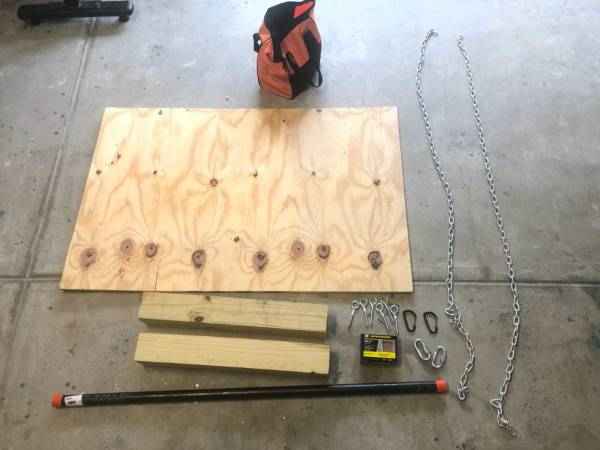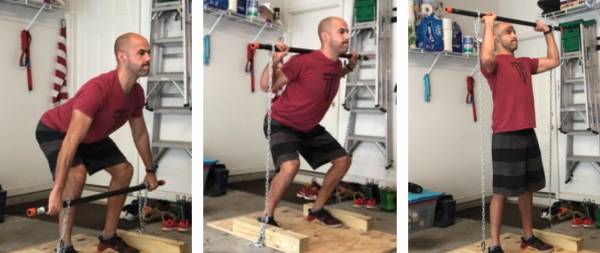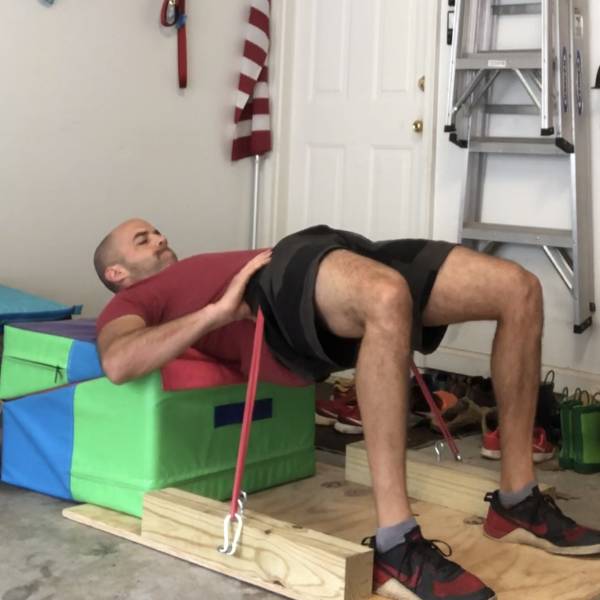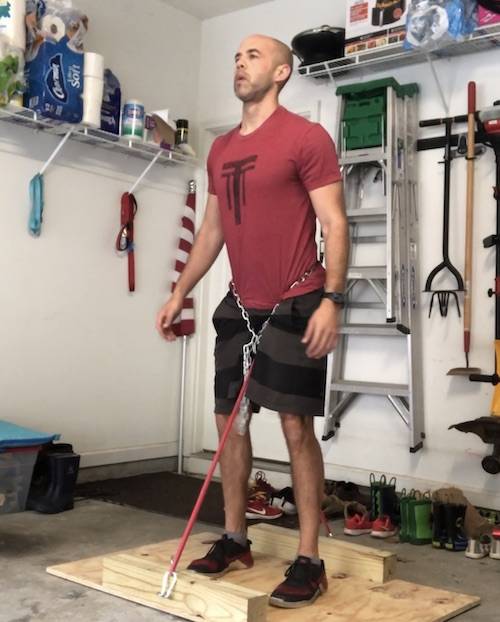While we all try to figure out how to navigate these trying times of lockdowns and social distancing, we seem to have this weird mix of lots of time to train but a lack of options with which to utilize.
The challenges of training from home (minimal equipment and space being the main ones) have made it really difficult to create strength training options that can at least preserve, or possibly continue to develop, the levels of force production and neural drive necessary for athletes.
While we all try to figure out how to navigate these trying times of lockdowns and social distancing, we seem to have this weird mix of lots of time to train but a lack of options with which to utilize.
The challenges of training from home (minimal equipment and space being the main ones) have made it really difficult to create strength training options that can at least preserve, or possibly continue to develop, the levels of force production and neural drive necessary for athletes.
When this situation finally resolves and we are able to start competing again, those who were able to consistently still get exposure to these kinds of stimuli will have a dramatic performance advantage over those who could not.
One of the best solutions that exists for this is a setup and program that utilizes specific variations of isometrics.
Isometric contractions can be performed safely with minimal equipment, meaning that we no longer need to overwhelm Rogue/Amazon with orders, nor our wallet with big purchases. They also can work inside of a small space, meaning that being stuck inside with just a garage or even just a living room no longer has to be a major obstacle.
I came across the above set-up awhile back from Ross Enamait of Ross Training, a super creative guy and awesome innovator in the strength and conditioning world.
As we continued to realize the situation that a lot of people were going to be faced with for the foreseeable future, I started to realize the potential value that this set-up could bring.
By providing options for isometric contractions to be done with minimal equipment and space demands, we can offer options for folks to still get some strength exposure in as we wait for things to blow over.
The set-up can also be expanded upon really easily, as I will show below, to provide many more training options. Adding to the wide range of isometric options, we can also perform banded dynamic work, banded strength work, vertical and horizontal upper body pulling, vertical and horizontal upper body pressing.
Not only do we provide an opportunity for folks to regain access to strength work, we also dramatically increase their exercise options on the whole to avoid things getting too monotonous.
The Isometric Set-Up Supplies

- Plywood – 48”x 36” (This can be any size really, just ensure you have enough surface area to get good squat/pressing positions.)
- 4′ piece of 4×4, cut in half
- 2 pieces of chain, mine are about 6’ long each
- Steel pipe (I got a 1” diameter here so it would replicate a 28.5mm barbell.)
- Carabiners x 2-4
- 2” eye screws x 4-6 (You really only need 2 initially, but the add-ons will use extra.)
- 4” deck screws (I only used 8 in total.)
Total cost: Around $75.
The Isometric Set-Up Basic Construction
I am about as far away from a handyman as someone can possibly get, and still this project took me about 15 min in total to put together.
Figure out approximately how far apart you want the 4×4 pieces to be by taking a regular squat stance, then placing the pieces of 4×4 outside of your feet on each side. You can then place the plywood on top of the pieces, centering it as best you can, and then use your deck screws to secure plywood on the top.
Then, flip it over, and screw the eye screws into the middle of the 4×4 pieces (I pre-drilled some holes just to make this a little easier). Connect the chain to the eye screws with the quick link connectors. Use the carabiners to adjust the length of the chain.
I chose to use the steel pipe to attach to the chains versus Ross’ set-up where he had the playground handles, mostly because I wanted to ensure that there were options for isometrics in a front/back rack as well, not just holding in hands, but you can do both if you want.
Overcoming Isometrics
There are multiple types of isometric contractions: isolated versus complex, endurance versus explosive, overcoming versus yielding. All of these have specific methods and goals. Our set-up above is designed mostly to equip us for overcoming isometrics.
Overcoming isometrics occur when the athlete creates force in an attempt to overcome an external force. These will be near-maximal or maximal effort, which means creating as much tension as possible for a short duration.
For our purposes during this time where most of us are faced with a lack of access to conventional strength equipment, we can utilize these maximal effort contractions to achieve a potent strength stimulus as well as maintain higher levels of neural drive.
Being able to include these sessions 2-3x/week means that we are much less likely to have experienced decay in our strength and power production when it is time to return to normal training.
Some examples below of overcoming isometrics through hinging, squatting, and pressing patterns. A huge benefit of using chains and connectors is that it allows us to easily vary the positions and heights at which we perform the isometric contractions. We can quickly switch from isometric pulls to isometric squats, adjusting height as needed with the carabiners.

Tips for Implementing Isometrics
Without diving into too much science and nuance, here are some quick tips for how to program and perform isometrics at home.
Give thought to the joint angles at which you want to improve your ability to produce force, and try to replicate them as closely as you can. Strength gains tend to be pretty specific to the angle that is trained, +/- 15 degrees, though this can be somewhat minimized if you place the muscle in a lengthened state (i.e. performing an isometric contraction on a muscle in a lengthened state leads to a much greater transfer of strength to other joint ranges of motion).
If you’re working on a strength lift, place the contraction around your usual sticking point. If you’re working on a dynamic lift, go close to the point of maximal acceleration. Alternately, you can find a position that is weak/unstable for you and attack that to build better strength and control.
When performing a maximal effort overcoming isometric (like the kind pictured above where the athlete is driving hard against an immovable object), take 1-2 seconds to ramp-up to your max effort contraction, hold there for the length of your rep, then take 1-2 seconds to ramp down. Don’t just slam into the resistance, this can compromise both position and balance and you will lose the benefit.
After you perform your overcoming isometric, do a few reps of your target movement pattern in order to “grease the groove” of force production in the pattern that will directly impact your sport performance.
Banded Add-Ons
Moving away from isometrics, there are some additional options we have by incorporating some bands for those who have access to them. As I was putting this together, I noticed the similarities to other minimal products on the market for banded hip thrusts.
By placing some additional eye screws into the sides of the 4×4 pieces, you can create an easy station to do band resisted hip thrusts, and its easy enough to change the height and stimulus of these by going from the floor or placing upper back on a bench/chair/couch.

This same band set-up can also be used to do banded glute marches. Utilizing the chains and carabiners, we can make a belt attachment for the band to hook to.
We can also perform banded push-ups, banded overhead presses, band resisted squats, band resisted pulls, etc. The options begin to increase really quickly with the addition of some bands.

Additional Isometric Set-Up Add-Ons
A further addition that is planned, but not yet executed, is to use some PVC pipe to attach to the 4×4’s and create some high parallel bars. These can be used for horizontal pulling, vertical pulling, dip/support holds, and L-sit variations.
I will update either this form or my social media posts to include details on that after we add them on. My hope is that we can come up with a cheap, simple, and effective set-up that anyone with access to a home improvement store can build and immediately improve upon their training options.






